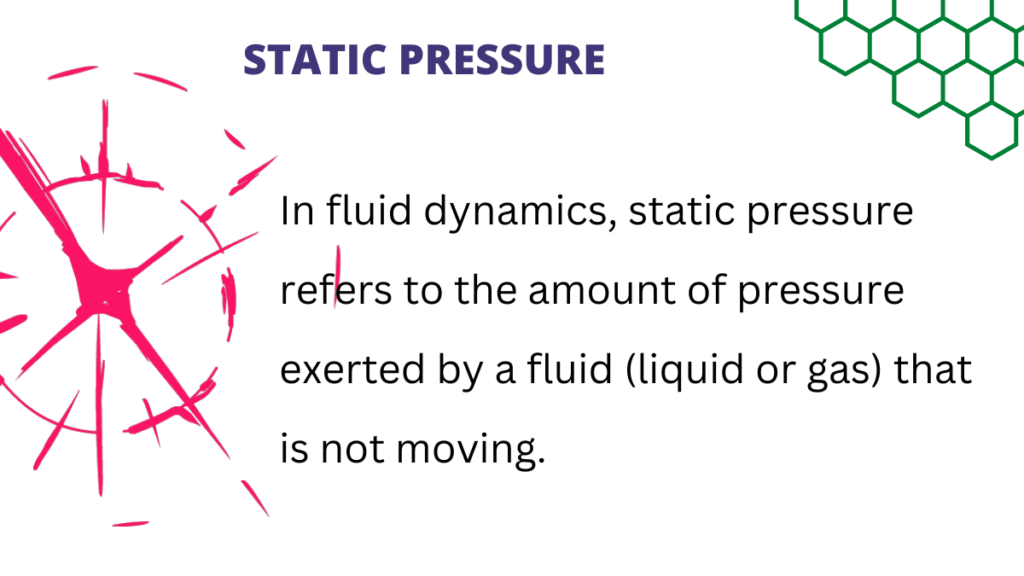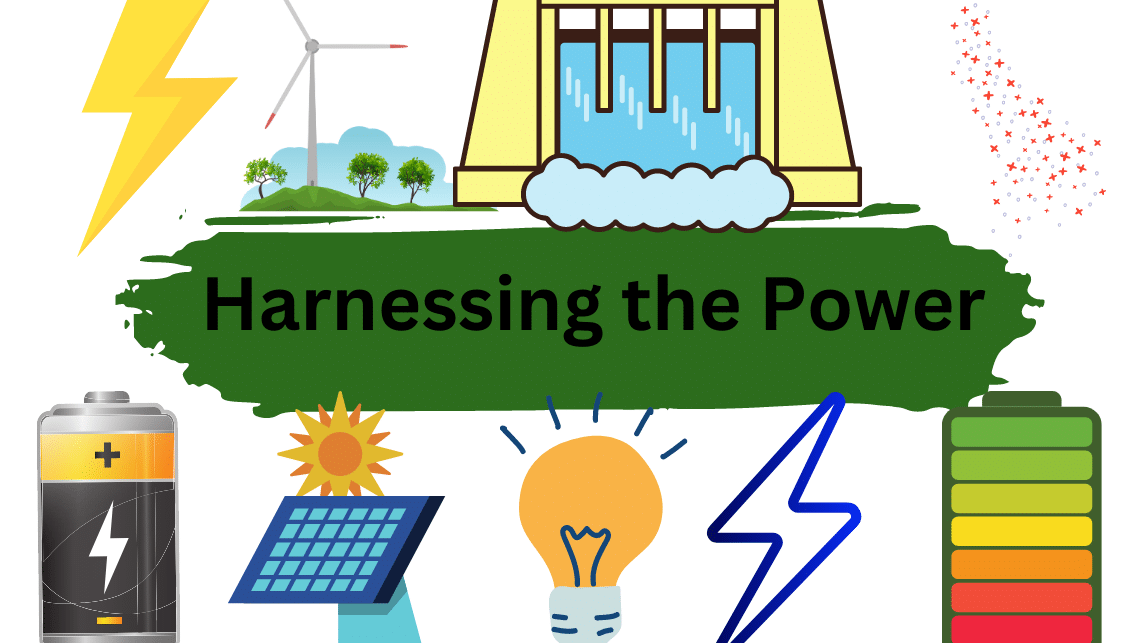In fluid dynamics, static pressure refers to the amount of pressure exerted by a fluid (liquid or gas) that is not moving. It is commonly measured using a force divided by an area, or in length units when using a pressure head. Some examples of static pressure are:
- The pressure of the atmosphere at the flight level of the aircraft.
- The pressure inside a balloon
- Static pressure is the measure of the force (potential energy) of a unit of air in a particular cross-section of a duct.

Atmospheric pressure is the total pressure of the air including static pressure and also dynamic/velocity pressure or the pressure caused by air moving. Therefore, atmospheric pressure is the sum of dynamic pressure and static pressure.
Static pressure is measured in millimetres of mercury (mmHg), kilograms per square meter (kg/m2), or pounds per square meter (Pa). When the static pressure is greater than atmospheric pressure, it is positive; when it is less than atmospheric pressure, it is negative. Some of the examples are listed below:
Table of Contents
Static Pressure Formula
The pressure exerted by a static fluid is completely defined by the fluid’s depth, density, and gravity (acceleration). The pressure in a static fluid is given by the expression and is derived from the fluid’s weight. In fluid dynamics, the Hydrostatic pressure equation: p=qgh
In this formula;
- p = pressure (N/m2)
- q = mass density of the fluid (kg/m3)
- g = acceleration due to gravity which = 9.8066 m/sec2
- h = height of fluid column (m)
Important Points
- Atmospheric pressure is the total pressure of the air, which includes static pressure as well as dynamic/velocity pressure, or pressure caused by moving air. As a result, atmospheric pressure is equal to the sum of dynamic and static pressures.
- When measured in relation to atmospheric pressure, static pressure equals gauge pressure. However, the static pressure can be measured using a vacuum as a reference, so that the measured value equals the absolute pressure.
- Static pressure decreases as altitude increases due to the absence lack of air above.
- Dynamic pressure is the pressure of a fluid that results from its motion. It is the difference between the total pressure and static pressure. Pilots rely on instruments that measure dynamic pressure to determine their airspeed.
Significance of Static Pressure in our Daily Life
Static pressure is an important concept in daily life as it affects a number of systems and devices that we use regularly. Here are a few examples of the significance of static pressure in daily life:
- HVAC systems: In heating, ventilation, and air conditioning (HVAC) systems, static pressure plays a crucial role in the distribution of air throughout a building. A properly designed HVAC system needs to maintain the right amount of static pressure to ensure that air is delivered effectively to all parts of the building.
- Fuel pumps in vehicles: In vehicles, static pressure is used to maintain fuel pressure in the fuel system, which is necessary for the engine to run properly. If the static pressure is too low, it can lead to a lack of fuel flow, causing the engine to stall or misfire.
- Water pumps: In plumbing systems, static pressure is used to control the flow of water in pipes. This pressure must be balanced to ensure that water is delivered effectively to all parts of the building and to prevent leaks and other problems.
- Blood pressure: In medicine, static pressure is used to measure blood pressure, which is an important indicator of a person’s overall health. Blood pressure readings can be used to diagnose conditions such as hypertension and heart disease.
- Wind turbines: In renewable energy, wind turbines rely on the pressure difference created by the wind to generate power. The static pressure of the wind is used to calculate the amount of energy that can be generated by a wind turbine.
Static Pressure vs Dynamic Pressure
Static pressure and dynamic pressure are two types of pressure that are often used in fluid mechanics, aerodynamics, and hydrodynamics. The difference between the two lies in how they are generated and how they affect the fluid or gas that they are acting upon.
Static pressure is the pressure that a fluid exerts on a surface when the fluid is not moving or is moving very slowly. It is the pressure that remains constant in a fluid that is not flowing. Static pressure is proportional to the fluid’s density and is determined by the depth of the fluid, the acceleration due to gravity, and the height of the fluid’s surface relative to a reference point.
Dynamic pressure, on the other hand, is the pressure that is generated by the movement of a fluid. It is proportional to the fluid’s velocity and density. Dynamic pressure is generated by the kinetic energy of the fluid and is affected by the fluid’s speed and the rate at which it is moving.
In aerodynamics, dynamic pressure is used to determine the lift force acting on an aircraft, while static pressure is used to determine the total pressure and the stagnation pressure of the airflow around the aircraft. In hydrodynamics, dynamic pressure is used to calculate the flow rate in a pipe or channel, while static pressure is used to calculate the pressure head or the pressure drop across a pump or valve.
| Dynamic Pressure | Static Pressure |
| Dynamic pressure is the continuous physical force exerted on an object by something such as air on fluid | Static pressure is the physical force exerted on an object that is not in motion |
| The fluid which has velocity or fluid that flows has Dynamic Pressure. | The fluid which is stationary has Static Pressure. |
| Dynamic pressure is the kinetic energy per unit volume of a fluid. | Static pressure is the pressure pushing on the walls. |
What is air?
Air is a homogeneous mixture of different gasses. The air in the atmosphere is composed of nitrogen, oxygen (which is required for animal and human life), carbon dioxide, water vapour, and trace amounts of other elements (argon, neon, etc.). At higher elevations, air contains ozone, helium, and hydrogen.
Summary
- “Static pressure is the pressure on the surface of an object at rest or in uniform linear motion. This pressure does not vary with time but varies with altitude.
- Atmospheric pressure is the sum of static pressure and dynamic pressure.
Related Links
Laminar Flow| Physics
Kinetic Energy Formula
Mechanical Energy Formula & Examples
Yield Point| Definition and Stress-Strain Relation
SI Unit of Work| Definition, Formula, and Examples
Conduction in Physics| Daily Life Examples
Frequently Asked Questions
1. What is an example of static pressure?
The pressure of a fluid or gas while it is not moving is referred to as static pressure. As an example, consider the pressure inside a balloon.
2. What is the difference between dynamic and static?
In general, dynamic refers to being active, capable of action and/or change, or powerful, whereas static refers to being immobile or fixed.
3. What is static pressure in airflow?
The potential energy of a unit of air in a specific cross-section of a duct is measured by static pressure. Static air pressure is defined as pressure on the duct wall. Consider a fan blowing into a totally closed duct; there will be no airflow through the duct, and therefore the fan will produce just static pressure.
4. What is the static pressure of liquid?
In fluid dynamics, static pressure refers to the amount of pressure exerted by a fluid that is not moving. When employing a pressure head, it is commonly measured as a force divided by an area, or in length units.
5. PV diagram
The pressure-volume diagram (abbreviated as the PV diagram) is a graphical depiction of pressure variations with respect to volume in a closed system. P-V diagrams can be used to determine a system’s efficiency and the work done by a system or on the system.
6. What is a Solar thermal power plant?
A solar thermal power plant absorbs and concentrates sunlight to generate the high-temperature heat necessary to generate electricity.
7. What is an alternative fuel vehicle?
An alternative fuel vehicle (AFV) is a vehicle that operates on fuels other than gasoline and diesel. Alternative fuels are obtained from non-petroleum sources.
More Interesting Links
Joke of the Day 🙂
Why did the pressure prefer to stay inside the pipe? Because it didn’t want to become static cling!
- BCl3 Lewis Structure in four simple steps - November 1, 2023
- PH3 Lewis Structure in four simple steps - October 8, 2023
- PF3 Lewis structure in four simple steps - September 24, 2023



